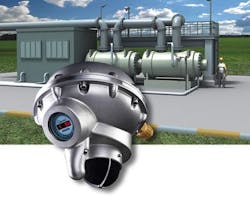Ultrasonic Gas Detector Protects Gas Compressor Stations
It is a non-concentration based gas detector used to detect leaks from high-pressure systems. It responds to the airborne ultrasound generated from gas releases in open, well ventilated areas. Since the Gassonic Observer responds to the source of a gas release rather than the dispersed gas, it is unaffected by changing wind directions, gas dilution and the direction of the gas leak.
The Gassonic Observer is based on robust microphone technology and provides a detection radius of up to 20 meters at a leak rate of 0.1 kg/s. In addition, the detector offers the Senssonic™ integrated acoustic self-test, which periodically verifies the integrity of the electronic circuitry and the operation of the acoustic sensor. The detector features the following approvals: CSA, FM, ATEX, IECEx, and C-UL. The detector is SIL 2 suitable and is FM certified to IEC 61508.
In gas compressor stations, there is a high risk of fire and explosion due to a combination of intense heat, pressure and vibration. Two main processes typically take place: (1) Gas compression is performed in order to ensure the natural gas flowing through a pipeline remains pressurized and (2) gas chilling/cooling, which reduces the gas temperature. Both processes subject gas compressor equipment to high stresses.
Vibration and heat from nearby machinery, for example, can produce cracks on seals and flanges. Hydrogen sulfide, liquids, and undesirable particles in the natural gas stream can corrode pipelines and degrade components. Over time, prolonged exposure to these elements invariably leads to component failure and possibly to leaks of combustible material. Early detection of dangerous compressor gas leaks is critical to help mitigate the risk of fire in volatile locations.
The Gassonic Observer is designed with a high pass filter to remove frequencies below 25 kHz, effectively eliminating interference from audible and low frequency ultrasonic noise. At the same time, setting the alarm trigger level above the ultrasonic background noise ensures immunity to other noise sources. The result is a reliable method of detection, able to monitor environments with high levels of ultrasound such as compressor stations.
General Monitors - www.generalmonitors.com

